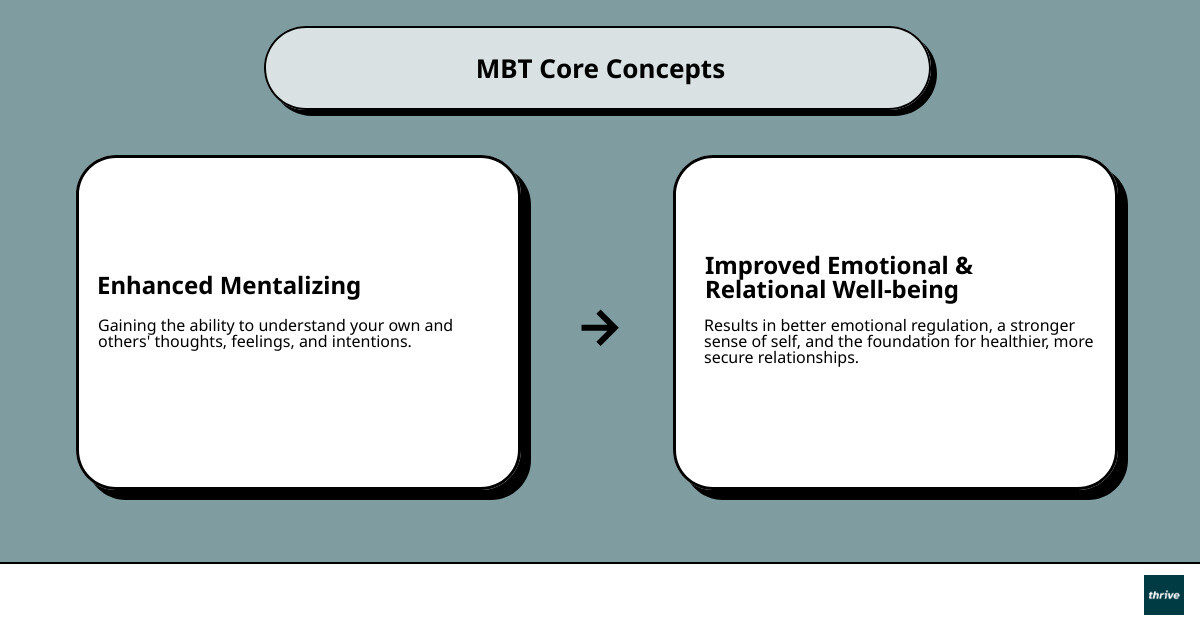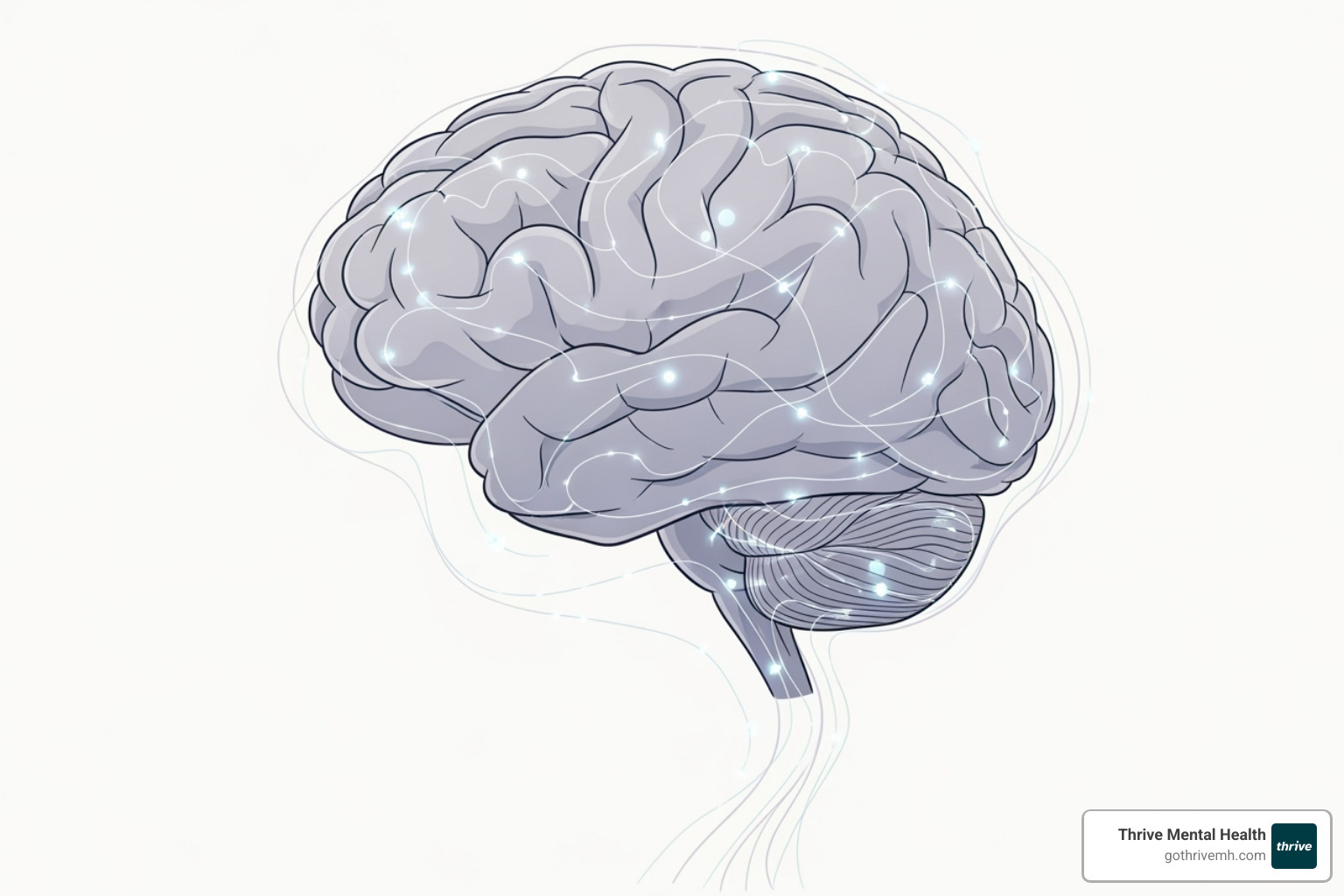Attachment Based Mentalization Therapy Explained (Without the Psychobabble)

Why Understanding Your Own Mind Matters More Than You Think
Attachment based mentalization therapy is a research-backed approach, developed by Peter Fonagy and Anthony Bateman, that helps you understand your own thoughts and feelings—and those of others—to build healthier relationships. It strengthens your ability to “mentalize,” which means pausing to think about what’s happening in your mind and the minds of those around you.
Quick Overview: What You Need to Know
- What it is: A therapy that combines attachment theory with mentalization skills
- Who it helps: People with relationship difficulties, emotional instability, personality disorders, depression, and anxiety
- How it works: By improving your ability to understand mental states (yours and others’)
- Duration: Typically 12-18 months of individual and/or group sessions
- Core focus: Building secure relationships and emotional regulation through better self-awareness
When you’re upset, do you assume you know why someone did what they did? Most of us do, but these assumptions are often wrong. Understanding the real “why” behind behavior—both yours and theirs—can transform your relationships.
Research shows that difficulty with “mentalizing” is common in people who struggle with anxiety, depression, or relationship problems. This isn’t about being analytical; it’s the basic ability to pause and consider: What am I feeling? What might they be feeling? What’s driving this behavior?
I’m Nate Raine, CEO of Thrive Mental Health, and I’ve seen how attachment based mentalization therapy helps people break free from destructive patterns. My experience in behavioral health innovation has shown me that the most effective treatments address both our mental processes and the relational patterns we learned early in life.

The ‘Why’ Behind MBT: Understanding Mentalizing and Attachment
Have you ever wondered why some people seem to “get” emotions while others struggle? The answer lies in mentalizing, the heart of attachment based mentalization therapy.
Mentalizing is the ability to understand that behavior is driven by mental states like thoughts and feelings. It’s about thinking about feelings to see yourself from the outside and understand others from the inside. This skill helps you manage emotions, solidify your identity, and build healthier relationships. Think of it as an internal GPS for human behavior, helping you steer social situations thoughtfully instead of just reacting.

What is Mentalizing and Why is it So Important?
Mentalizing is the foundation of self-awareness and empathy. It helps you understand your inner world—why you react certain ways, what triggers you—and genuinely grasp someone else’s perspective.
Without strong mentalizing skills, you might constantly misunderstand intentions or get caught in emotional storms. You might feel like you lack a stable sense of self, changing depending on who you’re with. This ability develops in early childhood development when caregivers help a child make sense of their feelings. If those early relationships are confusing, the capacity to mentalize can be damaged.
The Link Between Attachment and Attachment Based Mentalization Therapy
John Bowlby’s attachment theory explains that our early bonds with caregivers create internal working models—unconscious blueprints for relationships.
With secure attachment, caregivers are responsive, creating the perfect environment to develop mentalizing skills. You learn that your inner world makes sense. But insecure attachment happens when caregivers are inconsistent or dismissive. Children don’t get the emotional guidance they need and may learn to shut down their feelings or become confused about their inner states.
This is why attachment based mentalization therapy is so powerful: it directly addresses these early patterns to rebuild your capacity to understand mental states. The scientific research on attachment and mental states shows that as attachment security improves, so does mentalizing. These patterns aren’t set in stone; therapy can help you develop these skills at any point in life.
The Core of Attachment Based Mentalization Therapy: What Happens in a Session?
An attachment based mentalization therapy session is a collaborative journey where you and your therapist work together to understand what’s happening in your mind and the minds of others. The therapist takes a “not-knowing” stance, approaching your experience with genuine curiosity rather than assumptions.
The goal is to learn to pause and reflect. Your therapist will guide you to rewind difficult interactions, exploring the thoughts and feelings that were present. The focus on the present moment is also crucial, as your therapist will often bring attention to what’s happening in the therapy room. This helps re-establish mentalization when it gets lost during intense emotions. Both individual and group therapy sessions offer unique benefits for personal exploration and practicing new skills.
Core Principles and Therapeutic Stance
The heart of MBT is a collaborative relationship that feels secure and supportive, creating a safe base for exploration. Your therapist takes an active role, not by giving advice, but by focusing on your mind and helping you become curious about your own mental processes.
Therapists avoid jargon, using simple interventions in everyday language. A key skill you’ll develop is managing emotional arousal; your therapist will help you stay in a state where you can reflect rather than just react. This process builds epistemic trust—the ability to trust and learn from others—making you more open to new perspectives.
Key Techniques Used to Rebuild Mentalizing
MBT uses several gentle but powerful techniques to strengthen your ability to understand mental states:
- Exploring the context of events: Looking beyond what happened to examine the thoughts, feelings, and circumstances surrounding difficult moments to reveal hidden patterns.
- Clarification and challenge: Gently questioning rigid ways of thinking and helping you articulate your experiences more clearly.
- Affective focus: Paying close attention to emotions, helping you identify, separate, and understand your feelings.
- Tracking misunderstandings: Turning communication breakdowns into learning opportunities by exploring what went wrong from different perspectives.
- “Stop and Rewind”: Pausing during intense moments to go back to a calmer point and explore what happened in your mind and body.
- Exploring the therapeutic relationship: Using your interactions with the therapist as a real-time way to understand how your relationship patterns play out.
These techniques work together to rebuild your mentalizing abilities. At Thrive Mental Health, we tailor these methods to your individual needs in our intensive outpatient programs and one-on-one therapy. You can learn more about our specific therapy programs here: https://gothrivemh.com/services/mbt.
Who Benefits from MBT and How Does it Work?
Attachment based mentalization therapy was first designed for Borderline Personality Disorder (BPD), but its benefits extend to many other mental health struggles. When we can’t make sense of our own thoughts and feelings, or those of others, life becomes incredibly difficult. If you find yourself constantly misreading situations, feeling overwhelmed by emotions, or stuck in destructive relationship patterns, you may need to strengthen your ability to mentalize.

Mental Health Conditions Treated with MBT
Struggles with mentalizing, or mentalization deficits, can lead to impulsivity, unstable relationships, and identity disturbance—a confusing feeling of not knowing who you are. Emotional dysregulation, where emotions become so intense they overwhelm your ability to think, is also common. Some people may turn to self-harm to cope with this pain.
Attachment based mentalization therapy goes deeper than symptoms, helping people understand the workings of their own minds and the minds of others. The therapy has shown remarkable results for BPD and other personality disorders (like antisocial or narcissistic traits), eating disorders, depression, anxiety, PTSD, and substance use issues. Because mentalizing is a foundational skill, strengthening it makes everything else more manageable.
Documented Outcomes and Effectiveness
The research on attachment based mentalization therapy is impressive, showing reduced symptoms, improved social functioning, and decreased hospitalizations. Crucially, studies report lower suicide attempts and less self-harm as people learn to manage their emotional world.
What sets MBT apart are the long-term benefits, which can improve over time. In remarkable 8-year follow-up studies, only 14% of people who completed MBT still met the criteria for BPD. Participants were more likely to hold jobs, need less medication, and report better life satisfaction years after finishing therapy. Learning to mentalize creates a positive spiral: understanding yourself and others leads to better relationships, which fosters security and strengthens mentalizing.
You can explore more of the evidence for MBT in treating BPD here: https://www.ncbi.nlm.nih.gov/pmc/articles/PMC2816926/. Behind every statistic is a person who learned to build secure relationships and create a meaningful life.
How MBT Compares to Other Therapies
Attachment based mentalization therapy stands out by blending the best of different approaches. It draws from psychodynamic therapy’s focus on relationships, cognitive approaches’ attention to thought patterns, and systemic therapy’s view of how we connect with others. This powerful combination creates a comprehensive treatment for both your inner world and your relationships. Unlike therapies focused on symptoms, MBT addresses the underlying mental processes that drive how you think, feel, and relate to others.
MBT and Other Approaches to Personality and Relationships
While other effective treatments exist, MBT is unique in its explicit focus on understanding mental states. The key difference is its emphasis on the “why” behind behaviors. Instead of just teaching coping skills, MBT helps you explore the landscape of your inner world to understand what’s happening in your mind during difficult moments.
This approach addresses the root causes of interpersonal difficulties. The therapist’s inquisitive stance is also distinctive. They act as a curious collaborator, not an expert with all the answers, creating a safe atmosphere for exploration. This builds trust and connection (epistemic trust), making you more open to new ways of understanding yourself and others.
How Insecure Attachment and Mentalizing Affect Personality
Insecure attachment patterns in childhood often affect the ability to mentalize, which can influence personality traits throughout life. Maladaptive personality traits can develop as protective strategies. For instance, someone might develop negative affectivity (intense, hard-to-manage emotions) or detachment (withdrawing from relationships).
Other patterns include antagonistic traits (manipulation, grandiosity) or disinhibition (acting impulsively). The hopeful news is that strong mentalizing skills can buffer against these difficulties, even for those with a history of insecure attachment.
This is exactly what attachment based mentalization therapy does. By creating a secure therapeutic relationship and strengthening your ability to understand mental states, MBT helps shift these long-standing patterns. The result is more stable emotions, healthier relationships, and a clearer sense of self, addressing the fundamental processes that cause interpersonal problems.
You can explore more about our comprehensive approach to personality disorders here: https://gothrivemh.com/services/personality-disorders.
Finding the Right Support and Taking the Next Step
Seeking therapy is a courageous step. For attachment based mentalization therapy, finding the right therapist is key, as the therapeutic relationship is the heart of the treatment. This relationship becomes a secure base where you can safely learn to understand your own mind and the minds of others.

What to Look for in a Mentalization-Based Therapist
When searching for an MBT therapist, consider the following:
- Certified training: Look for licensed mental health professionals who have completed formal, specialized MBT training through recognized programs. This matters because MBT is a specific approach with unique techniques.
- Experience with personality disorders: A therapist who understands complex personality patterns will better grasp the nuances of mentalization difficulties.
- A curious and non-judgmental attitude: Your therapist should be genuinely interested in your experience, not judging or rushing to fix you. They should help you make sense of your confusion collaboratively.
- Focus on the therapeutic relationship: A good MBT therapist will use the “here and now” of your interactions to explore your relationship patterns.
- Good fit: Most importantly, trust your gut. You need to feel safe, understood, and respected.
Finding the Right Therapist for Attachment Based Mentalization Therapy
When you contact potential therapists, don’t be afraid to ask questions to ensure they’re the right fit for you.
- What is your training in MBT? Ask about their specific training and if they receive ongoing supervision.
- How do you incorporate attachment concepts? This helps you understand if they grasp the link between early relationships and current struggles.
- What does a typical session look like? Get a sense of their approach and whether they offer individual, group, or both.
- How do you handle moments of intense emotion in therapy? A skilled MBT therapist can help you “stop and rewind” when emotions get too high.
At Thrive Mental Health, our expert-led team knows that the right therapeutic fit is essential. We offer both virtual and in-person options, adapting to your needs while maintaining the core principles that make attachment based mentalization therapy effective. The journey starts with a conversation—you don’t have to figure this out alone.
Conclusion: Reconnecting With Yourself and Others
The journey through attachment based mentalization therapy is more than managing symptoms; it’s about refinding the ability to understand your own mind and connect authentically with others. Many of us were never taught how to make sense of our inner worlds, especially if early relationships were confusing or invalidating.
MBT offers hope for rewriting those early lessons. It helps you develop a crucial “pause button” to step back and ask, “What’s really happening here? What am I feeling? What might they be feeling?” This isn’t about overanalyzing, but about building a foundation for genuine emotional regulation and meaningful connections.
By strengthening this natural human capacity, you learn to see yourself from the outside and understand others from the inside. Relationships become a source of connection, not conflict. You build a coherent sense of self, and emotional storms become more manageable because you understand them.
At Thrive Mental Health, we’ve witnessed countless individuals break free from patterns that once seemed unchangeable. Our expert-led care creates the secure base you need to explore your inner world safely. Healing happens in relationship—both with your therapist and with yourself.
If you’re ready to begin this journey of reconnection, we’re here to support you. Our flexible, evidence-based approach means you can access the care you need. Learn more about how our intensive outpatient programs can provide the foundation for lasting change: https://gothrivemh.com/services/intensive-outpatient.
Seeking help is a courageous step toward the life you deserve. You have the capacity to heal, grow, and to thrive.